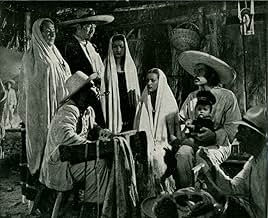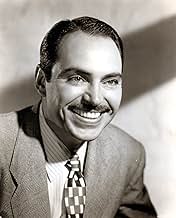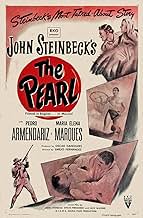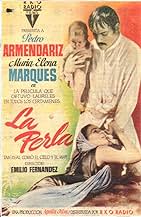CALIFICACIÓN DE IMDb
7.4/10
1.2 k
TU CALIFICACIÓN
El descubrimiento de una perla perfecta cambia para siempre la vida de un pobre pescador mexicano y su familia.El descubrimiento de una perla perfecta cambia para siempre la vida de un pobre pescador mexicano y su familia.El descubrimiento de una perla perfecta cambia para siempre la vida de un pobre pescador mexicano y su familia.
- Dirección
- Guionistas
- Elenco
- Premios
- 9 premios ganados y 6 nominaciones en total
José Arratia
- Tratante de perlas
- (sin créditos)
Guillermo Calles
- Indio rastreador
- (sin créditos)
Enrique Cancino
- Pueblerino
- (sin créditos)
Maria Elena Cuadros
- Juanita
- (sin créditos)
Columba Domínguez
- Pueblerina
- (sin créditos)
Enedina Díaz de León
- Yerbera
- (sin créditos)
Agustín Fernández
- Pueblerino
- (sin créditos)
Rogelio Fernández
- Pueblerino
- (sin créditos)
Raquel García
- Pueblerina
- (sin créditos)
Opiniones destacadas
By the advent of the pearl, everyone appears to be changed in character into a monster of greed, except the protagonists, the fisherman, his wife and their baby, who instead turn into refugees and victims. It's an anatomy of greed with a definite morality, that a great fortune must lead to greed, criminality, death and loneliness. It doesn't have to be like that, but in this story, that is definitely the case in hopeless despair with no illusions surviving, As the pearl enters their lives they start dreaming of all the possibilities it imports, and there is great festivity in the entire village, as all the poor people rejoice in the fisherman's good fortune, but there are always opportunists, and at the appearance of a chance of fortune they will go at any length and sacrifice all human values for their greed. A return to absolute poverty seems to be the only solution to the problem. John Steinbeck's story is a grim study in the weakness of common man, what is lacking here is any wisdom in any man, the fisherman doesn't even have any reliable friend whom he can trust for advice, and the one who helps him gets shot for it. It is impossible not to have objections against such a hopelessly dark and bleak assessment of man, since there must be alternatives. Nothing is completely black, and although the fisherman and his wife survive their via crucis, there must be a new life for them.
This is a wonderfully shot film whose story, while not totally believable, could serve as allegory. Perhaps the family of the Mexican fisherman-diver played by Armendariz would have been happier if he had not discovered the pearl at all, but the poverty that endangers their baby's life makes his joy at this discovery (in a good underwater scene) credible. Immediately afterward, he finds himself beset by freeloaders and robbers (including his own brother), and the spiral continues until it ends in flight, hunger, death and a sort of redemption: the pearl is hurled back into the sea that spawned it. Apart from the story, the highlight is the Mexican scenery, the village and villagers, and the skillful and evocative camera angles. As one reviewer wrote, it's unlikely a villagers' celebration would have been as elaborate as the one shown in "La Perla," but it is enjoyable. Perhaps one semi-cynical message that could be gained from this film is that if you strike it rich, tell as few people as possible.
Making an adaptation off John Steinbeck's short novel wasn't easy and always a feat.But Emilio Fernandez and Gabriel Figueroa did it in a succesful way.
Pedro Armendariz repeats on a high class of acting role as in 'Maria Candelaria'. Once again the cinematography of Gabriel Figueroa ranks among the best he's done. (the cinematography of this movie earned him, a prize at the Cannes Film Festival).
The aid of Mr. Steinbeck himself, helped Emilio to adapt the screenplay just as good as the novel itself.
This movie has no flaws and it ranks among the best in Mexico Film History, a must see.
Pedro Armendariz repeats on a high class of acting role as in 'Maria Candelaria'. Once again the cinematography of Gabriel Figueroa ranks among the best he's done. (the cinematography of this movie earned him, a prize at the Cannes Film Festival).
The aid of Mr. Steinbeck himself, helped Emilio to adapt the screenplay just as good as the novel itself.
This movie has no flaws and it ranks among the best in Mexico Film History, a must see.
Apparently this piece is uncomfortable for people who simplify into moralism its complexity and forcefulness in what it has to say both explicitly and implicitly, aspirationism for wealth and the discord and greed it provokes, bourgeois class robbery of the working class, colonialist extractionism, whiteness as a jewel that gives privilege, all this as true then as it still is, set in a melodrama full of anguish, plus of course a beautiful montage in which the photography and the masterful underwater sequences stand out, marvellous at the time and which stand the test of time with great neatness.
The Pearl is directed by Emilio Fernández and John Steinbeck co-adapts his own novella of the same name with Fernández and Jack Wagner. It stars Pedro Armendariz, María Elena Marqués, Fernando Wagner, Gilberto González, Juan García and Charles Rooner. Music is by Antonio Díaz Conde and cinematography by Gabriel Figueroa.
We are in La Paz, Mexico, and when Quino and Juana's son is stung by a scorpion the couple are anguished by not having the finances to pay for medical treatment. Hope springs eternal when Quino discovers a large pearl, something which is seemingly the answer to their prayers - is it?
What we basically have here is a morality play about the corruption of greed. Once the pearl of the title is discovered the ugliness of mankind rears its vile head. People around Quino and Juana - a homely honest but poor couple - suddenly have designs on the financial gains that the pearl can bring - with some of them willing to commit cardinal sins to achieve their aim. The pearl also begins to drive a wedge between the loving couple, and thus we are held enthral of the story to see exactly where this will all end up?
Though it's not very subtle in the telling, with Steinbeck's literary bent often as heavy as a sledgehammer, this is undeniably compelling stuff. That it's also a visual delight also considerably aids the viewing experience. Fernández and Figueroa bring truly atmospheric cinematography into play as a key character of the piece, with kinked frames and low level shots perfectly embracing the discord of the troubling human conditioning on view. Come 1947 what we would come to know as the film noir style of film making was in full effect, fans of such should for sure add The Pearl to their must seek out lists. 8/10
We are in La Paz, Mexico, and when Quino and Juana's son is stung by a scorpion the couple are anguished by not having the finances to pay for medical treatment. Hope springs eternal when Quino discovers a large pearl, something which is seemingly the answer to their prayers - is it?
What we basically have here is a morality play about the corruption of greed. Once the pearl of the title is discovered the ugliness of mankind rears its vile head. People around Quino and Juana - a homely honest but poor couple - suddenly have designs on the financial gains that the pearl can bring - with some of them willing to commit cardinal sins to achieve their aim. The pearl also begins to drive a wedge between the loving couple, and thus we are held enthral of the story to see exactly where this will all end up?
Though it's not very subtle in the telling, with Steinbeck's literary bent often as heavy as a sledgehammer, this is undeniably compelling stuff. That it's also a visual delight also considerably aids the viewing experience. Fernández and Figueroa bring truly atmospheric cinematography into play as a key character of the piece, with kinked frames and low level shots perfectly embracing the discord of the troubling human conditioning on view. Come 1947 what we would come to know as the film noir style of film making was in full effect, fans of such should for sure add The Pearl to their must seek out lists. 8/10
¿Sabías que…?
- TriviaEmilio Fernández, who was in love with Olivia de Havilland, thought she was the ideal actress to play the female starring role. De Havilland never knew of his secret love, but the director was able to get the government of Mexico City to change the name of the street he grew up on to "Dulce Olivia" (Sweet Olivia).
- Citas
Narrator: This is a story that old men tell to children. They aren't sure where it happened or when.
- Versiones alternativasA short version (77') was shown in the USA, France and West Germany whereas a longer version (85 to 87') was shown in Mexico and East Germany.
- ConexionesAlternate-language version of The Pearl (1948)
Selecciones populares
Inicia sesión para calificar y agrega a la lista de videos para obtener recomendaciones personalizadas
- How long is The Pearl?Con tecnología de Alexa
Detalles
- Tiempo de ejecución1 hora 25 minutos
- Color
- Relación de aspecto
- 1.37 : 1
Contribuir a esta página
Sugiere una edición o agrega el contenido que falta
























